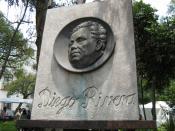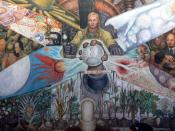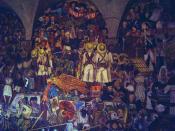Diego Rivera, An Essay
Diego Rivera México (1886-1957) Diego Rivera's art was one of the columns on which one of the strongest movements in American painting was to find support: Mexican muralism. His art rests on a foundation from a mixture of Gauguin, Aztec, and Mayan sculpture. Diego Rivera, used simplified forms and vivid colors. He brilliantly rescued the pre-Colombian past, as well as the cornerstones of Mexico's history: the land, the factory and land workers, the customs and the popular way of life.
Diego Rivera's contribution to modern Mexican art was decisive in murals; he was a revolutionary painter who wanted to take art to a wider audience, to the street and buildings, using a precise and direct language with a realistic style, full of social meaning. It was always Rivera's ambition to artistically depict the events, ideas and hopes of the Mexican Revolution. To find a suitable method to accomplish this, he tried the fresco technique, which consists of painting directly on a wet mixture of sand and lime, to help the color penetrate and be fixed when the mixture dries.
Again in Europe, Rivera presented his work in Madrid and Paris.
The murals that Rivera painted in Mexico made him so famous that he became not only the leader of a painting movement, but also a political leader. His activities in the latter field placed him at the center of several controversies and adventures. For example, the Hotel del Prado in Mexico City refused to show a large fresco that bore the words "Dios no existe" ("God does not exist"). Diego, in turn, refused to erase it, until he finally gave up after returning from a trip to the Soviet Union in 1956 because of health problems. Diego Rivera was a member of...


